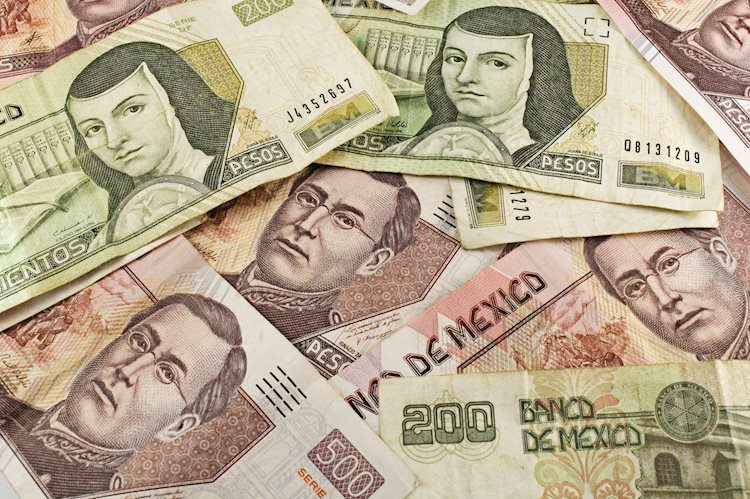- The Mexican Peso extends its weakness into a fourth day as multiple risks lead traders to press “sell”.
- Trump Tariff threats, a critical IMF report, political risks and weak data all combine to weigh on the Mexican currency.
- USD/MXN extends its rally from the base of a major rising channel as technical indicators point north.
The Mexican Peso (MXN) seems to be rinsing and repeating the depreciation of the past few days on Thursday as market bears – now more confident in the persistence of the evolving downtrend – push the Peso lower in all its key pairs.
A cocktail of ingredients is contributing to the Peso’s shakedown, including former president Donald Trump’s threat to slam Mexican auto imports with tariffs of up to 300%, an International Monetary Fund (IMF) report that highlighted a slowdown in economic activity; political risk, and a deterioration of Consumer Confidence data for September.
Mexican Peso cracks as Donald thumps imports piñata
The Mexican Peso declined on average 1.5% on Tuesday, after Donald Trump said in an interview with Bloomberg News that “Mexico is a tremendous challenge for us.” He went on to explain how China was building mega car-manufacturing plants on the US-Mexico border, from where it was flooding the US market and hounding out US competitors.
Trump vowed to stop the practice by reinstating high tariffs and so enable a regeneration of the US auto industry. Given the significance of the automotive industry to the Mexican economy, as well as the demand for Peso’s generated by exports to the US, the former president’s comments weighed on MXN..
Mexican Peso undermined by IMF report
The Mexican Peso saw further weakness after the IMF published a report on Tuesday in which it forecast Gross Domestic Product (GDP) growth slowing to 1.5% at the end of 2024. This comes after the most recent GDP data showed the economy grew 2.1% in Q2. It is also below the Bank of Mexico’s own 2.1% forecast for 2024, although it is slightly higher than the average of the responses in the Banxico’s September survey of private-sector analysts of 1.45%.
The main reasons for the slowdown were given as “binding capacity constraints and a tight monetary policy stance” as well as weaker-than-expected growth in the US and the “unforeseen effects from recent institutional reforms”, according to the report. The latter refers to the controversial judicial reform, which has spooked markets.
In regards to headline inflation, the IMF saw this falling to the Bank of Mexico’s (Banxico) 3.0% target in 2025, in line with the central bank’s own forecasts but below the Banxico survey average forecast of 3.86% (3.80% median).
Banxico set to cut and cut rates again before year-end
Further downwards pressure on the Peso comes from expectations of lower interest rates, which reduce foreign capital inflows. The central bank is expected to cut the prime interest rate by 50 basis points (bps) (0.50%) before the end of 2024, bringing it down to 10.00% from 10.50%.
This is reflected in Banxico’s survey mean forecasts, which show respondents project a fall in the bank rate to an average of 10.04% by the end of 2024 (10.00% median) and 8.09% by the end of 2025 (8.00% median).
Technical Analysis: USD/MXN extends recovery from base of rising channel
USD/MXN extends its recovery from support provided by the base of a rising channel as well as the (red) 50-day Simple Moving Average (SMA) nearby.
USD/MXN Daily Chart
USD/MXN is now probably in a short-term uptrend, which given the technical analysis principle that “the trend is your friend,” is biased to continue.
The break above the 19.83 (October 1 high) target will now probably lead to a move up to between 20.10-20.15 and the vicinity of the September 10 high at 20.13.
The Moving Average Convergence Divergence (MACD) (blue) line is rising sharply and has broken above its (red) signal line, further indicating a bullish bias.
Banxico FAQs
The Bank of Mexico, also known as Banxico, is the country’s central bank. Its mission is to preserve the value of Mexico’s currency, the Mexican Peso (MXN), and to set the monetary policy. To this end, its main objective is to maintain low and stable inflation within target levels – at or close to its target of 3%, the midpoint in a tolerance band of between 2% and 4%.
The main tool of the Banxico to guide monetary policy is by setting interest rates. When inflation is above target, the bank will attempt to tame it by raising rates, making it more expensive for households and businesses to borrow money and thus cooling the economy. Higher interest rates are generally positive for the Mexican Peso (MXN) as they lead to higher yields, making the country a more attractive place for investors. On the contrary, lower interest rates tend to weaken MXN. The rate differential with the USD, or how the Banxico is expected to set interest rates compared with the US Federal Reserve (Fed), is a key factor.
Banxico meets eight times a year, and its monetary policy is greatly influenced by decisions of the US Federal Reserve (Fed). Therefore, the central bank’s decision-making committee usually gathers a week after the Fed. In doing so, Banxico reacts and sometimes anticipates monetary policy measures set by the Federal Reserve. For example, after the Covid-19 pandemic, before the Fed raised rates, Banxico did it first in an attempt to diminish the chances of a substantial depreciation of the Mexican Peso (MXN) and to prevent capital outflows that could destabilize the country.
Read the full article here

